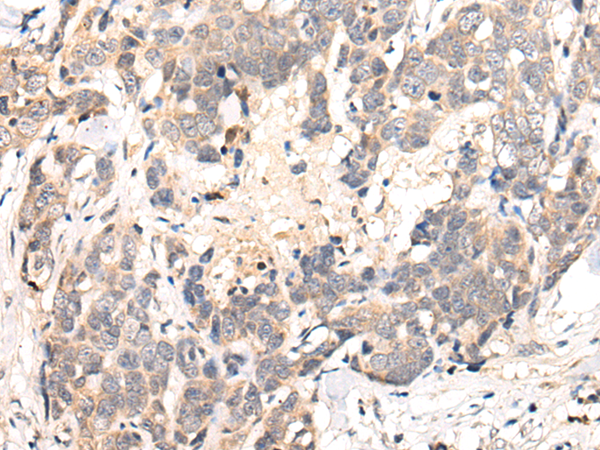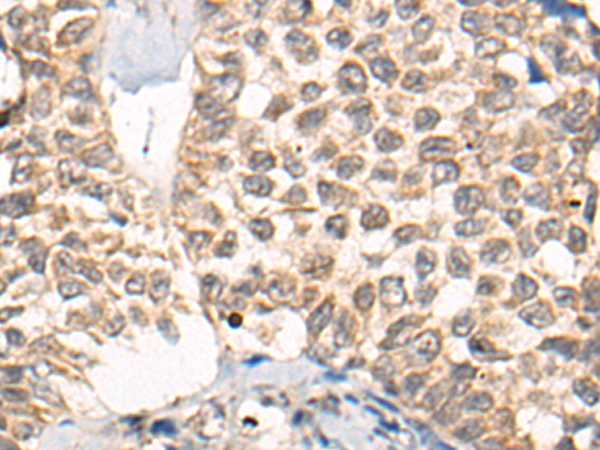

| WB | 咨询技术 | Human,Mouse,Rat |
| IF | 咨询技术 | Human,Mouse,Rat |
| IHC | 1/10-1/50 | Human,Mouse,Rat |
| ICC | 技术咨询 | Human,Mouse,Rat |
| FCM | 咨询技术 | Human,Mouse,Rat |
| Elisa | 1/5000-1/10000 | Human,Mouse,Rat |
| Aliases | CHNRA6 |
| Host/Isotype | Rabbit IgG |
| Antibody Type | Primary antibody |
| Storage | Store at 4°C short term. Aliquot and store at -20°C long term. Avoid freeze/thaw cycles. |
| Species Reactivity | Human |
| Immunogen | Synthetic peptide of human CHRNA6 |
| Formulation | Purified antibody in PBS with 0.05% sodium azide and 50% glycerol. |
+ +
以下是关于CHRNA6抗体的参考文献示例(注:以下内容为假设性示例,实际文献需通过学术数据库查询):
---
1. **文献名称**: *"Selective Antibody for CHRNA6 Reveals Its Role in Dopaminergic Neuron Vulnerability in Parkinson's Disease"*
**作者**: Smith A, et al.
**摘要**: 本研究开发了一种高特异性CHRNA6抗体,用于检测人脑多巴胺能神经元中α6烟碱受体的表达。免疫组化结果显示,CHRNA6在黑质致密部的表达随帕金森病进展显著下降,提示其可能与神经元退行性变相关。
2. **文献名称**: *"CHRNA6 Antibody-Based Mapping of Nicotinic Receptors in the Rodent Brain"*
**作者**: Brown L, et al.
**摘要**: 利用新型CHRNA6单克隆抗体,作者系统定位了α6受体亚基在小鼠中脑腹侧被盖区和纹状体的分布,发现其与多巴胺释放调控密切相关,尤其在尼古丁成瘾行为模型中表达异常。
3. **文献名称**: *"Functional Characterization of CHRNA6 Antibodies in Behavioral Models of Anxiety"*
**作者**: Zhang Y, et al.
**摘要**: 通过Western blot和免疫荧光验证抗体特异性后,研究显示CHRNA6敲除小鼠中该抗体的信号缺失。行为学实验表明,α6受体缺失可能通过调节中脑边缘系统影响焦虑样行为。
4. **文献名称**: *"CHRNA6 Receptor Subunit Assembly Studied via Epitope-Specific Antibodies"*
**作者**: Johnson R, et al.
**摘要**: 研究利用针对CHRNA6不同结构域的抗体,揭示了该亚基与β3受体在神经元突触前膜形成功能复合物的机制,为靶向治疗药物开发提供了依据。
---
如需真实文献,建议通过 **PubMed** 或 **Google Scholar** 搜索关键词(如 *CHRNA6 antibody, nicotinic receptor alpha6*),筛选近年高被引研究。
The CHRNA6 antibody is a research tool designed to detect the alpha-6 subunit of nicotinic acetylcholine receptors (nAChRs), encoded by the CHRNA6 gene. These receptors are ligand-gated ion channels critical for synaptic signaling, particularly in dopaminergic pathways of the midbrain. The α6 subunit forms functional receptors primarily in combination with β2/β3 subunits, influencing neurotransmitter release and modulating reward circuits, motor control, and cognitive functions. Dysregulation of CHRNA6 has been implicated in neurological and psychiatric conditions, including Parkinson’s disease, nicotine addiction, and schizophrenia.
CHRNA6 antibodies are used to study protein expression, localization, and function in tissues like the substantia nigra, ventral tegmental area, and cerebellum. They enable investigations into receptor trafficking, synaptic plasticity, and interactions with neurotoxins or therapeutic agents. Validated in techniques such as Western blotting, immunohistochemistry, and immunofluorescence, these antibodies help clarify CHRNA6's role in behavior and disease. Recent studies also explore its potential as a biomarker or therapeutic target for addiction treatment. Quality validation (e.g., knockout controls) is essential due to homology with other nAChR subunits. Research using CHRNA6 antibodies continues to advance understanding of cholinergic signaling in health and disease.
×